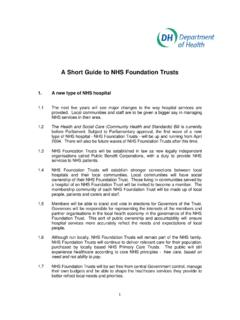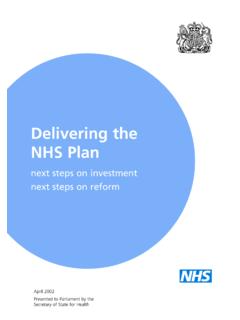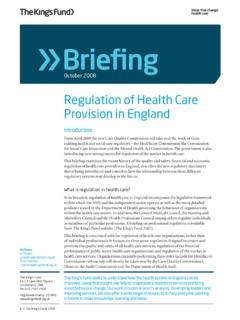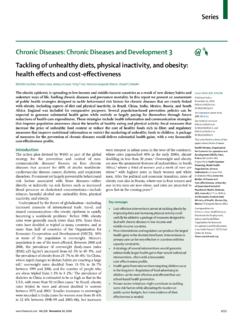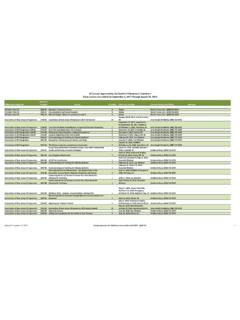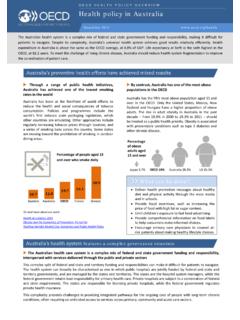Transcription of Choosing Health - Executive Summary - nhshistory
1 Summary 15/11/04 12:41 pm Page ofciCHOOSING Health Making healthy choices easier Executive Summary Working in partnership across government with people, their communities, local government, voluntary agencies and business 1 Choosing Health Executive Summary 2004 Executive Summary Introduction 1. England has a proud history of improving the Health of its people. Over the past three centuries, the combined impact of individuals, families, communities, national and local government, education, business and industry, and voluntary, faith and charitable bodies has seen unthought of progress in the Health of the people of England.
2 2. Some of that progress has been driven by wider social, economic, environmental and cultural trends as England benefited from economic growth, improving education, better housing and better sanitation. In the twentieth century Health services also began to make a significant impact, gathering pace after 1948 as the establishment of the NHS enabled free universal provision of immunisation, screening and treatment to make in roads into ill Health and premature death. 3. The role of Government in the prevention of ill Health during this time was often a top down approach, reflecting the cultural and political relationships of the times.
3 In the post war era of deference in a homogenous society, Public Health was often seen as something that was done to the population, for their own good, by impersonal and distant forces in Whitehall and the public bodies and professionals that it directed, with varying degrees of success. 4. As rapid progress was made on the big killer infectious diseases of the past, more intractable issues and conditions such as cancer and coronary heart disease came to the fore. The absence of obvious simple, quick solutions to these diseases and the increasing preoccupation of the NHS in coping with rising demand for treatment, meant that too often public Health was diverted into better analyses of the problems they were witnessing rather than practical solutions.
4 With widening Health inequalities, a sharp rise in obesity , a slowing in the decline of smoking rates, growing problems with alcohol, teenage pregnancy and sexually transmitted diseases, old ways of thinking about and responding to public Health problems were, increasingly being shown to be inadequate. 5. While there were many notable successful public efforts, such as the response to HIV and AIDS, too often work to tackle longstanding, intractable or emerging problems was increasingly caught up in a sterile national debate, disconnected from the real lives of the public, that created a false dichotomy between those proposing a heavy handed nanny state on one hand, and those supporting inactivity bordering on neglect in the name of individual freedom on the other.
5 2 6. At the same time, new opportunities have been opening up rapidly. The public is now used to consuming a range of goods and services and enjoy the choices available to them. However, they look to Government to assist them with information about healthy and unhealthy choices. Not to make the decisions for them, but to provide them with clear information. Information technology and the internet have transformed the way in which we can communicate information. At the same time, the NHS is freeing itself from a decades old crisis focused on waiting for treatment, which is creating the time, space and resources needed for effective action on prevention.
6 Now action to improve Health and to provide the practical support to achieve this is needed urgently. Paragraphs 11 33 summarise many of the key actions we are putting into place. A new approach to the Health of the public 7. The time is now right for action. At the start of the twenty first century England needs a new approach to Health of the public, reflecting the rapid and radical transformation of English society in the latter half of the twentieth century, responding to the needs and wishes of its citizens as individuals and harnessing the new opportunities open to it.
7 To sustain and build upon an historic track record of progress and effectiveness, it needs policies and approaches which reflect the realities of people s lives today. That means an approach which respects the freedom of individual choice in a diverse, open and more questioning society; which recognises the realities of the impact of the consumer society on those choices; which addresses the fact that too many people and groups have been left behind or ignored in the past; and which moves forward at the pace which the people of England want and will support.
8 Reconnecting with people s lives 8. The first and critical stage in that process was to listen to the views of the people in England, to get in touch with their real concerns and to ask what they wanted and how they could be helped to realise their aims. For this White Paper, it is the public who have, for the first time, set the agenda and identified what for their own good means, not Whitehall. They have made clear where they want support, where they want to be left alone by Government and where they want Government to intervene.
9 They have also made clear that they wish to see change. Chapter 1 the time for action on Health and Health inequalities describes the extensive and unprecedented consultation that has gone into reshaping public Health policy for the public and by the public. 3 Choosing Health Executive Summary 2004 Underpinning principles 9. That process has enabled us to establish three core principles of a new public Health approach. These underpin the whole of this strategy, and are set out in Chapter 1: (1) Informed want to be able to make their own decisions about choices that impact on their Health and to have credible and trustworthy information to help them do so.
10 They expect the Government to provide support by helping to create the right environment. However, this principle is subject to two qualifications. First, people believe that we need to exercise a special responsibility for children who are too young to make informed choices themselves. Second, people agree that we need special arrangements for those cases where one person s choice may cause harm or nuisance to another, such as exposure to second hand smoke. We need to balance rights and responsibilities, in ways that protect Health .
